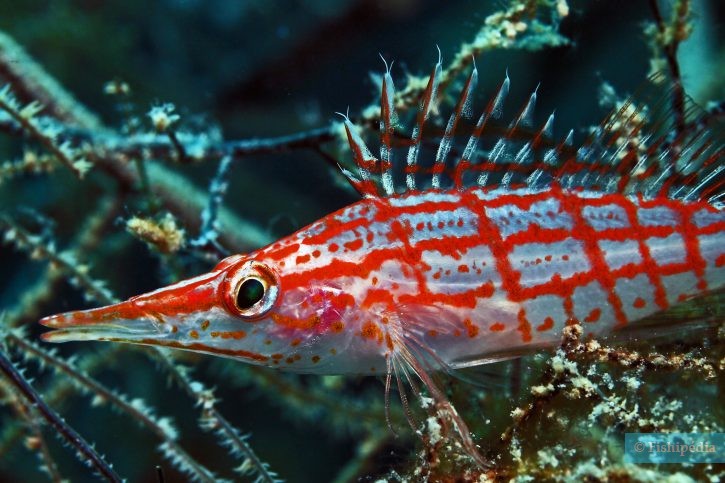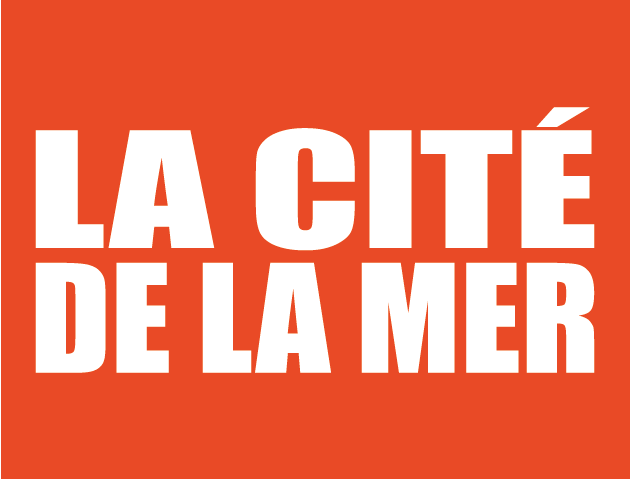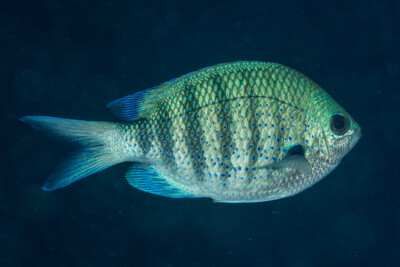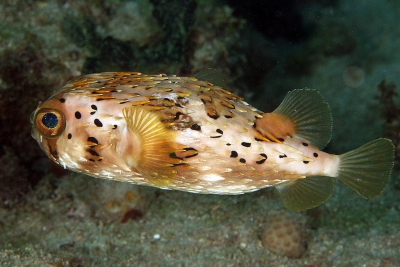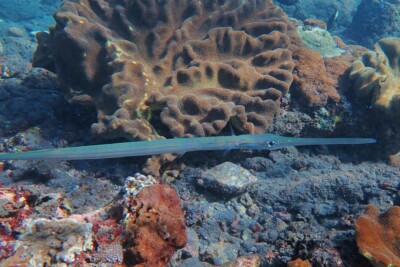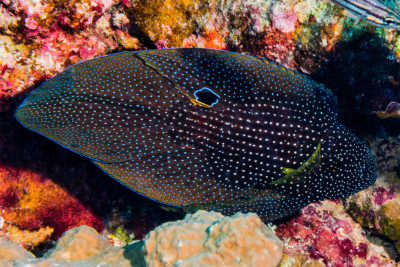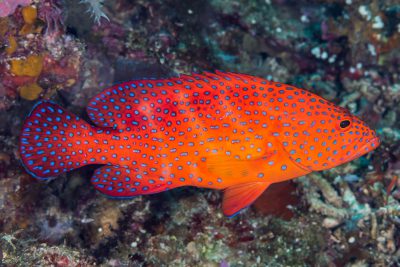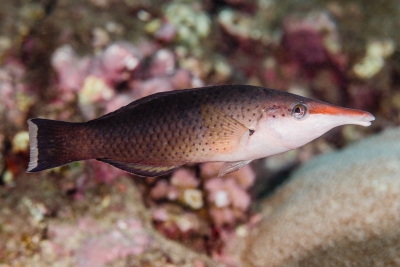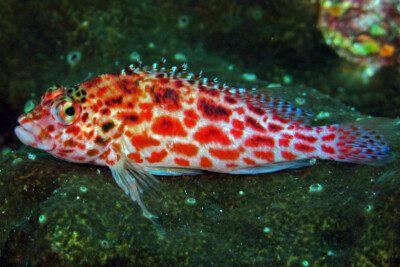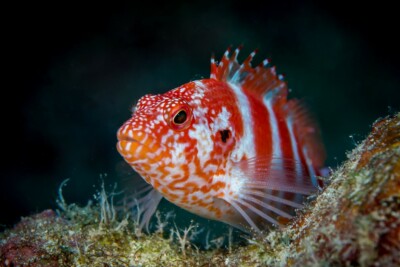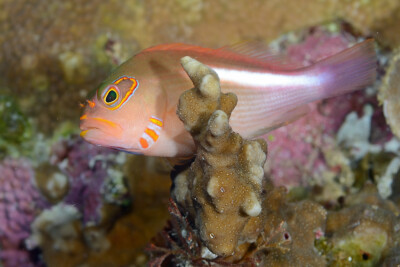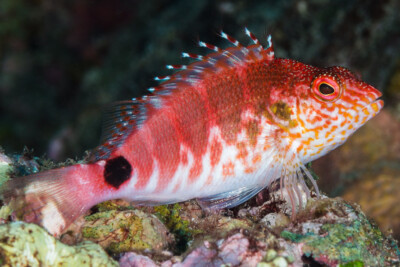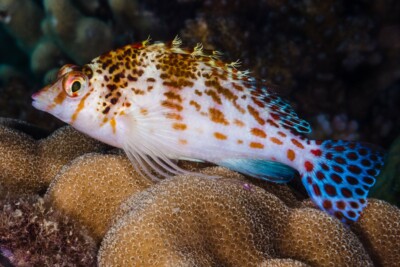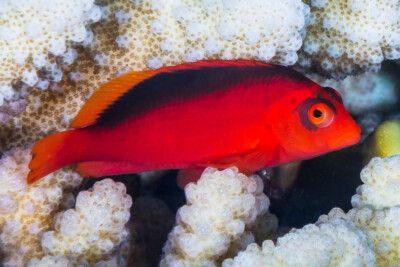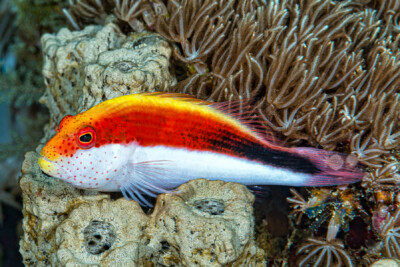longnose hawkfish
| Scientific name | Oxycirrhites typus |
|---|---|
| Descriptor | Bleeker |
| Year of description | 1857 |
| IUCN category (World) | LC |
| Family | Cirrhitidae |
| Genus | Oxycirrhites |
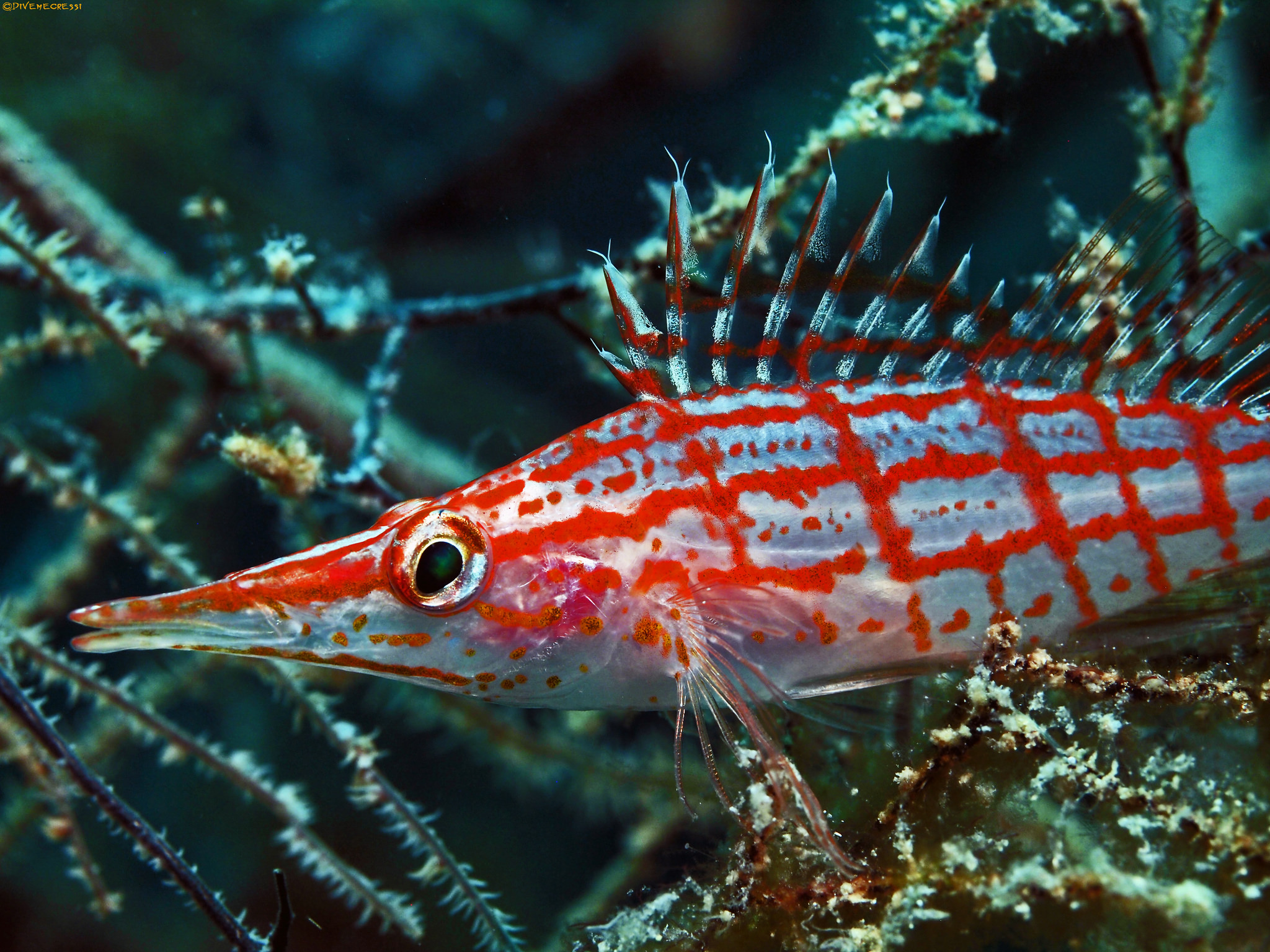

Introduction
Oxycirrhites typus, commonly known as the longnose hawkfish, is a saltwater fish originating from the Indo-Pacific region. It frequents coral reefs from the Red Sea to Polynesia.
Who is it?
Morphology
-
Average size11 cm
-
Maximum size13 cm
-
Longevity8 year
-
Patternmultiple
-
Average size11 cm
-
Maximum size13 cm
-
Longevity8 year
-
Patternmultiple
How to recognize This fish ?
The body is fusiform with a large and elongated mouth. The fish is striped with horizontal and oblique red bands forming a grid pattern. The dorsal, pectoral, anal, pelvic, and caudal fins are dotted with red, forming stripes. The single dorsal fin has protrusions at the end of the first rays.
Sexual dimorphism
There is no apparent dimorphism in this species. However, being protogynous, females are generally smaller than males.
Behaviour & Life cycle
-
dietcarnivorous
-
Sociabilityliving as a couple
-
territorialYes
-
Way of livingdiurnal
The longnose hawkfish is a solitary or pair-living fish. It is a species with a calm temperament that spends most of its time in sea fans and black corals between 10 and 100 meters deep.
It is an ambush predator, waiting for small fish and invertebrates that it feeds on.
Reproduction
-
Reproductionovipare qui pond en eau libre
-
Hermaphroditeprotogynous
This species is a protogynous hermaphrodite. Reproduction occurs at sunset in open water. Males and females successively rise in the water column to release their spawn.
This species is believed to exhibit monogamous behavior. In the wild, it is typically seen in pairs. However, during the breeding season, individuals may spawn and fertilize their eggs simultaneously.
Harmless species
This species does not pose a particular danger to humans if encountered in its natural habitat.
Origin and distribution

What is its habitat?
Natural environment characteristics
-
Temperature22 - 26 °C
-
Depth10 - 100 m
Biotope presentation
The longnose hawkfish is commonly found in coral reefs, at depths less than 100 meters. However, it is not uncommon to find this fish at other depths. This species swims little and spends most of its time perched on its pelvic fins in sea fans.
Species of the same biotope
Main recommendations for fishkeeping
Deontology
In order to preserve wildlife, if you acquire this animal, it must not be released into the wild. See also, the Fishipedia charter.
Fishipedia supports the practice of responsible and environmentally friendly aquarium keeping. We encourage maintenance if it is motivated by a desire to understand the biological functioning of living things and if it is done with respect for animal life.
We believe that aquaristics is an opening to the discovery of aquatic environments, especially freshwater, and that this knowledge is necessary to better protect and respect these environments. Logically, we refute the compulsive purchase of animals that would not find a sufficient and / or adapted place in the host aquarium.
Our recommendationsThese tips apply to adult species from breeding. With regards to water conditions, wild species or close relatives must be kept under the same conditions as in their area of origin.
-
Min volume110 liters
-
Population min1
-
Temperature22 - 26 °C
-
pH (acidity)8.2 - 8.4
CharacteristicsThe characteristics below apply for adult species. They correspond to an average of cases, validated in maintenance condition.
-
Difficulty breedingThe farming difficulty is relative. It depends on experiments already carried out with similar species. First, it takes into consideration the robustness of the species, the ease of recreation of a favorable environment and the general behaviour with the other inhabitants of the aquarium.moderate
-
Robustnesstolerant
-
Behaviourslightly aggressive
-
Availabilityoccasional
General reminders
It is strongly advised to read the complete dedicated file and to get information on the feedbacks of maintenance of the envisaged animal, this to avoid any potential conflict whose end result is generally the death of the individual (or the other inhabitants). It is important not to overload your aquarium to limit pollution. This will make maintenance easier.
General reminder on maintenance datas
Le démarrage d'un aquarium est une partie primordiale pour l'équilibre et le bien-être des poissons. Lorsque l'on met en eau un aquarium, l'eau passe naturellement par un cycle biologique : le cycle de l'azote. Celui-ci dure environ trois semaines. Tous les 2 jours, nous vous conseillons de tester votre eau jusqu'à ce que le taux de nitrite soit à zéro pendant plusieurs jours d'affilée.
Pour accélérer ce cycle, vous pouvez utiliser un activateur de bactéries comme JBL Denitrol. Cette solution riche en bactéries vivantes et enzymes permet une mise en place rapide du cycle de l'azote. Les poissons peuvent alors être introduits plus rapidement.
Il est important de tester l'eau de son aquarium régulièrement pour maintenir un environnement sain pour les poissons et les autres habitants. Les tests d'eau permettent de mesurer les niveaux de différents paramètres tels que le pH, la dureté totale, ainsi que les taux de nitrates, de nitrites et d'ammoniaque.
Pour réaliser ces tests, vous pouvez utiliser des produits d'analyse spécialisés tels que JBL ProScan qui permet de réaliser un diagnostic de l'eau directement via un smartphone. Il existe également des coffrets de tests plus classiques de bandelettes, comme JBL PROAQUATEST.
En cas d’usage de l’eau du robinet, vous pouvez utiliser un conditionneur d’eau de type Biotopol de JBL pour éliminer les substances nocives comme le chlore, le cuivre, le plomb et le zinc. Les conditionneurs d'eau garantissent une meilleure santé aux poissons et une meilleure croissance des plantes.
Chlorine and chloramine are dangerous for the health of animals. Used to disinfect water, these agents are present in significant quantities in tap water. We recommend using an anti-chlorine agent every time you change the water. In addition to chlorine, treatments and medicines sold for aquarium use sometimes contain dangerous heavy metals in high doses.
Specific needs for the longnose hawkfish
The longnose hawkfish is a marine species which lives naturally at a temperature between 22 °C and 26 °C. For proper maintenance, the temperature should never exceed the 29°C for long periods. Nitrate levels should remain below 50mg/L. To keep the water clean and unpolluted, plan on changing 20% to 30% of the water volume each month. In seawater, it is also possible to remove nitrates using one of the following methods: Jaubert, denitrator on sulfur, biopeletts, vodka method.
The breeding of this species is accessible on condition of being well informed about its needs in aquarium . Any cohabitants must be chosen with care to avoid the loss of animals.
This species is generally available in specialized shops or from aquarium clubs. Specimens that have been bred for a long time are easier to breed, but special water parameters must be respected.
Formal incompatibilities
Cohabitation & Environment
This fish being a predatory species, it is recommended to maintain it in a specific environment, without other species. Indeed, any crustacean or fish of lower size will become a potential prey. A 110 liter aquarium is the minimum recommended for its maintenance. If you still try to associate it with other species, the cohabitants must be of a size at least comparable to the predator in a much larger volume. The aquarium can be provided with many hiding places and a large space to allow each individual to find refuge if necessary.
Tips for feeding
The longnose hawkfish is carnivorous.
This species does not appreciate being fed with freeze-dried food (flakes...). Some specimens will never eat this type of food.
You should not overfeed your residents to avoid polluting the water. For most species, it is better to feed a few small portions each day rather than one large meal.
Reproduction protocol
-
egg-laying protectionNo
Hybridization risks
In general, it is advised not to mix several species of the same genus or different varieties of the same species, to avoid the risks of hybridization.
These animals might interest you
These plants might interest you
Plants play a crucial role in aquariums, both for their ability to filter water by absorbing excess nutrients and for their aesthetic contribution. They provide fish with natural hiding places, can serve as breeding sites, and generally help maintain the overall balance and optimal conditions of the aquarium. The selection presented here includes species from the same regions as the species described on this page, although they do not necessarily come from its exact natural biotope.
To go further
Sources & Contributions
Participation & Validation
The Fishipedia team and specialist contributors are committed to providing high-quality content. However, although the information comes from scientific sources or testimonials from specialists, the cards may contain inaccuracies.
Translation
Translation done with the valuable contribution of our translators, who make this information available to a wider audience. We sincerely thank them for their commitment.
Bibliographic references
Pelagic spawning of the hawkfish Oxycirrhites typus (Cirrhitidae) - Terry J. Donaldson - Patrick L. Colin - Springer Nature - 1989.
Description of four small reef fishes from Ecuador: Oxycirrhites typus (Cirrhitidae), Acanthemblemaria balanorum (Chaenopsidae), Arcos decoris (Gobiesocidae) and Lythrypnus dalli (Gobiidae) - Philippe BÉAREZ - Jean-Thomas BUJARD - Roberto CAMPOVERDE - MNHM - 2007.
Facultative monogamy in obligate coral-dwelling hawkfishes (Cirrh tidae) - Terry J. Donaldson - Springer Nature - 1989.
Scientific partners
Tags
Species of the same family
Species of the same biotope
